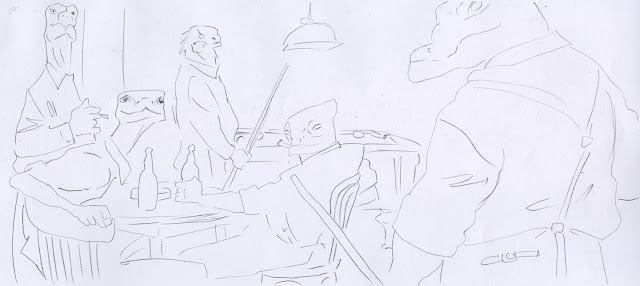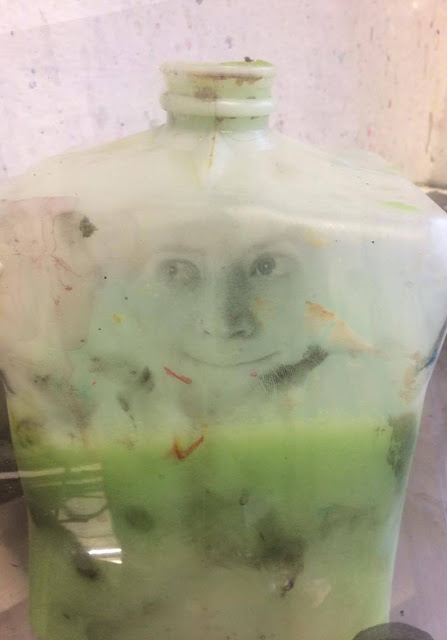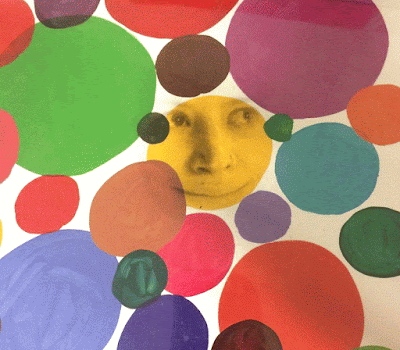THE IMAGE & ARTIST- Secret World of Things by Sean Charmatz- Gifs made by me.
 |
| [a] |
 |
| [b] |
 |
| [c] |
I think the simplicity of Sean Charmatz's anthropomorphized objects emphasizes the playful nature of his work, and I so I experimented with these by altering how realistic the 'characters' can be. This is also loosely looking into the 'sliding scale of anthropomorphism' [1] and the idea of the 'uncanny valley' [2] . I picked three examples of Charmatz's animations and altered each, from the original simple cartoon faces, to my more detailed cartoon faces, to a more realistic face, ending with a photographic face.
THE EXPERIMENTS
1. The Monster
ORIGINAL
Here the face on the blanket 'monster' is simple and child friendly. As with most of Charmatz's characters the eyes are just black circles that become lines when closed- and although the mouth features two pointy teeth we can tell by the facial expressions of the blanket monster that it is harmless- emphasised by the simple and 'cute' style that has been applied.
DETAILED CARTOON
I especially added more detail to the eyes and mouth, making the eyes bigger with eyebrows (to add a sneaky expression) and more teeth to make it sinister. The shapes of the eyes, nose and mouth are still cartoonish so although slightly creepier than the previous gif the monster still obtains it's silliness.
REALISTIC CARTOON
Whilst I tried to up the realism in the face I also brought down the amount of expression, to emphasise the creepiness of the monster. However, then I added blood which isn't very subtle at all.
PHOTOGRAPH
Again, where the realism has sky rocketed the expression has plummeted. Wearing a mask, I took pictures and then added the masked face to the blanket. Now a real monster- the photographic nature of the image one the one hand fits in with the real everything else (blanket, cat, house etc) but still looks out of place with its frozen smile and unblinking eyes. This is reminiscent of the 'uncanny valley', where a certain uneasiness is felt around something that is close to being real but isn't (the theory is usually applied to robotics, see below) [3]
 |
| [d] |
2. The Gum
ORIGINAL
Again, the cuteness of the gum is amplified by the simple features that have been added to it. The little stick legs can easily move and 'wiggle', and it only takes for them to be drawn crooked for us to know that his legs and arms are broken- however as this is not graphically depicted the gum is still cute and we are not disturbed by him being crushed.
DETAILED CARTOON
The action of the gum being squashed I highlighted by emphasising the arms and legs- making them bigger and taking up more space. I also stretched the face and made the eyes and mouth bigger in general- all of this emphasises the gum being squished but in a comedic, not gory way.
REALISTIC CARTOON
To make it more realistic and take it up the anthropomorphic scale I decided to add a hairstyle to the gum instead of arms and legs. Now the gum, complete with more realistic facial features and a dashing head of hair, resembles a head- which when squashed by the shoe makes us more uneasy compared to when the face was stylised and more cartoon-y. The tears, as with the blood on the previous gif, are there to add a certain 'darkness' to the gif.
PHOTOGRAPH
I think by using my own face I find this funnier than usual. Applying a photographic face to the gum means the audience can clearly see the facial expressions, and the character has gone from being cute to quite grotesque.
The use of of photos when anthropomorphising things also reminds me of Joel Veitch's animations of cats (see below) , most famously used for Crusha milkshake adverts. The unedited photo of a kitten at first looks cute, but then when animated dancing and singing with a human mouth collaged on top- it suddenly loses it's cuteness and turns a bit creepy.
[4]
3. The Bean
ORIGINAL
The basic style of the arms and legs are still expressive as they can be easily animated to move around wildly- I found the bean hardest to add realistic legs etc. to because of the space and how it falls.
DETAILED CARTOON
Probably my favourite gif I edited- due to the timing of the cheeky wink at the end. Again adding more detail but keeping it cartoonish manages to still convey the comedy of the original. The elongated legs also highlight the movement of the bean and contrast against the stillness of when it lands- which I think makes the wink even more funny.
REALISTIC CARTOON
As with the gum I kept the more realistic cartoon as just a face without adding the cartoon-y legs. The face has more realistic detail compared to the previous gifs, and I think juxtaposed on a bean it makes it look quite sinister (no-one wants a bean with teeth!)
PHOTOGRAPHIC
 |
| [e] |
By using anthropomorphism I can alter the 'seriousness' of an image and also the humour. As I have taken something simple and cute and tried to alter the realism to make it darker, by using a more realistic form of anthropomorphism I will try and make something serious, cuter.
THE IMAGE & ARTIST Blacksad by Juan Diaz Canales and Juanjo Guarnido
 |
| [f] |
Canales and Guarnido's Blacksad immediately communicates a dark and gritty atmosphere, reflected in the colours used as well as the semi- realistic animal/human hybrid depicted.
Before I try to make these characters less intimidating/cuter/ less anthropomorphised, I used the lightbox to roughly sketch out the position of each figure and the composition.
THE EXPERIMENTS
LESS REALISTIC
For this one I tried to mostly keep to the original, just making slight changes to the style by softening harsh angles and simplifying shapes. By the dynamic postures of the characters and the body language which is still detailed, the audience is still made slightly uneasy by the unwavering and intimidating eye contact. On TV tropes 'sliding scale of anthropomorphism', these characters fall under 'Petting Zoo People'. These animals don't even have tails, and have humanised body parts and clothes
MORE CARTOON
By following the "Funny Animals' trope, the characters have still got the body language of humans but now have less clothes and added tails to emphasis that they are are animal than human. In terms of style and 'cuteness vs. seriousness'- I've almost completed rounded off any sharp angles and 'cartoonised' the facial features. I have removed some of the human actions within the image like getting rid of the pool cues.
BASIC/CUTE
For the final image I have reflected Sean Charmatz's style by using extremely simplified dot eyes and line mouths. The clothes and items have been completed removed, and the body shapes now represent that of an animal. Still anthropomorphised- the characters are sitting/standing like people would. Although their glares are still there, they have been softened by the simplified cartoon style and I doubt anyone would be intimidated by this bunch.
Using the stages of 'basic', 'cartoon', ' collage eyes and mouth' and 'photographic'- I also wanted to try anthropomorphise items around the studio using acetate with faces painted/printed onto them:
Here we can see that the simple face will instantly add character to anything- whereas the other faces either don't quite fit or are too pale. The photo of my face does work in that it seems quite sinister, leaving a ghostly face on an object as opposed to the bold and basic smiley face which is more appealing.
Again compared to the simple smiley face, my face on items still creates a ghostly appearance which is weird and frightening. It also looks like a photo has been placed on a soap bottle (as above, for example) rather than the soap bottle has a face and therefore a character.
To mimic the simple style of Charmatz I wanted to try and animate some of the objects with simple smiley faces- showing how successful it can be to apply a simple face and movement to an object to create a character.
With the information I have found out from applying different faces to things, I can rearrange and combine the different levels of anthropomorphism to emphasises different moods and emotions.
Above the joyful cartoon face is juxtaposed with the grumpy photo- emphasising the sorrow and anger of being crushed by the shoe.
Here the photo face is emphasised by zooming in, and contrasts against the smiley cup. By the face changing, the audience can assume that it has been deeply affected by the water dripping down it's face.
Surprise/shock can also be conveyed by changing the scale of anthropomorphism, as can be seen above.
MY RESPONSE
Part 4. The Discovery
Harking back to my first response- I anthropomorphised mountains and rivers to create the characters- emphasising the forest setting of the story, also reflected by the fauna that forms the borders around the illustrations.
To emphasise points in the story, particularly the emotion of Goram, I have changed the simple cartoon face to a more realistic, zoomed in face. Not only does this accentuate his reactions by being able to use more detail, it also draws our attention to the reaction because of the juxtaposition of the simple with the realistic.
I rearranged the images to make it easier to read on screen- when printed I would fold it like a comic book. I also wanted to add extra emotion into the scenes- so by adding eyes to the trees and plants I created anthropomorphised forest, watching the drama happening as it unfolds.
Now there is more reaction on the page, which in turn highlights whats happening to the main characters, as the eyes draw our attention to the action.
REFERENCES
[1] TV TROPES. 2015
[2] SPECTRUM. 2012
[3] SPECTRUM. 2012
[4] RATHERGOOD. 2016.
[5] ANNOYING ORANGE. 2017
IMAGE REFERENCES
[a] CHARMATZ, SEAN. 2016
[b]CHARMATZ, SEAN. 2016
[c]CHARMATZ, SEAN. 2016
[d] MORI, MASAHIRO. 1970
[e] ANNOYING ORANGE. 2017
[f] GUARNIDO, JUANJO. 2010.
Bibliography
TV Tropes. 2015. Sliding Scale of Anthropomorphism. [Online]. [Accessed 6 Feb 2017]. Available from: http://tvtropes.org/pmwiki/pmwiki.php/Main/SlidingScaleOfAnthropomorphism
Spectrum. 2012. An Uncanny Mind: Masahiro Mori on the Uncanny Valley and Beyond. [Online]. [Accessed 6 Feb 2017]. Available from:
http://spectrum.ieee.org/automaton/robotics/humanoids/an-uncanny-mind-masahiro-mori-on-the-uncanny-valley
Spectrum. 2012. The Uncanny Valley: The Original Essay by Masahiro Mori. [Online]. [Accessed 6 Feb 2017]. Available from: http://spectrum.ieee.org/automaton/robotics/humanoids/the-uncanny-valley
Rathergood. 2016. Northern Kittens. [Online]. [Accessed 6 Feb 2017.] Available from:
https://www.youtube.com/watch?v=E1LFIzTubkw
Youtube. 2017. Annoying Orange. [Online]. [Accessed 6 Feb 2017] Available from:
https://www.youtube.com/user/realannoyingorange
Sean Charmatz. 2016. Secret World of Stuff SuperCut No.1. [Online]. [Accessed 6 Feb 2017] Available from: https://www.youtube.com/watch?v=dOFUYR2iX4c
Mori.M. 1970. Figure 1: Uncanny Valley. [Online]. [Accessed 6 Feb 2017]Available from: http://spectrum.ieee.org/automaton/robotics/humanoids/the-uncanny-valley
Guarnido, J. 2010. Blacksad. [Online]. [Accessed 6 Feb 2017]. Available from:
https://wall.alphacoders.com/by_sub_category.php?id=214332










































No comments:
Post a Comment